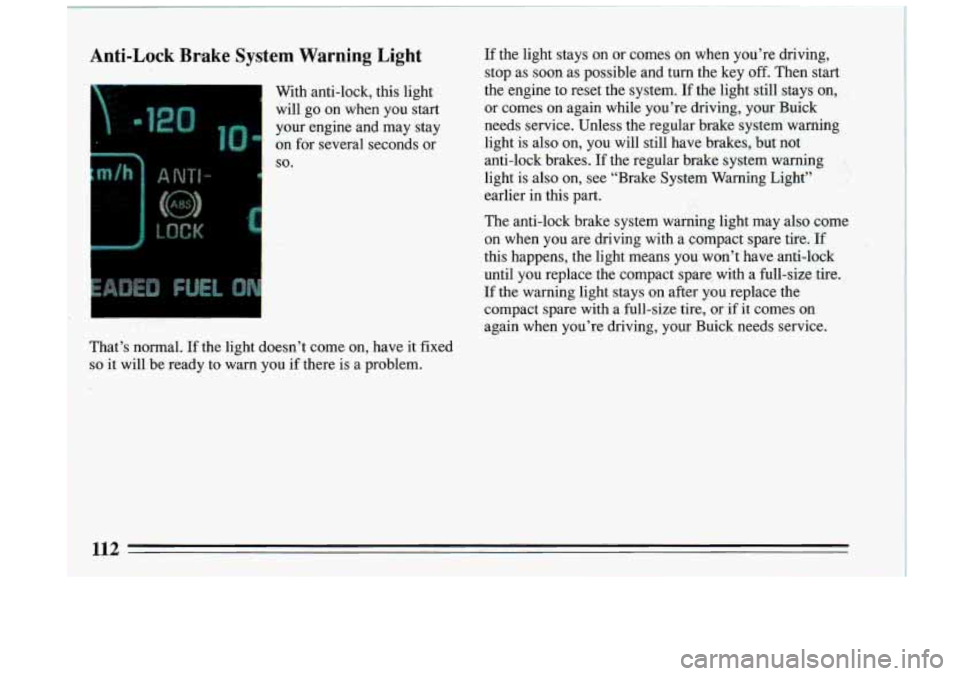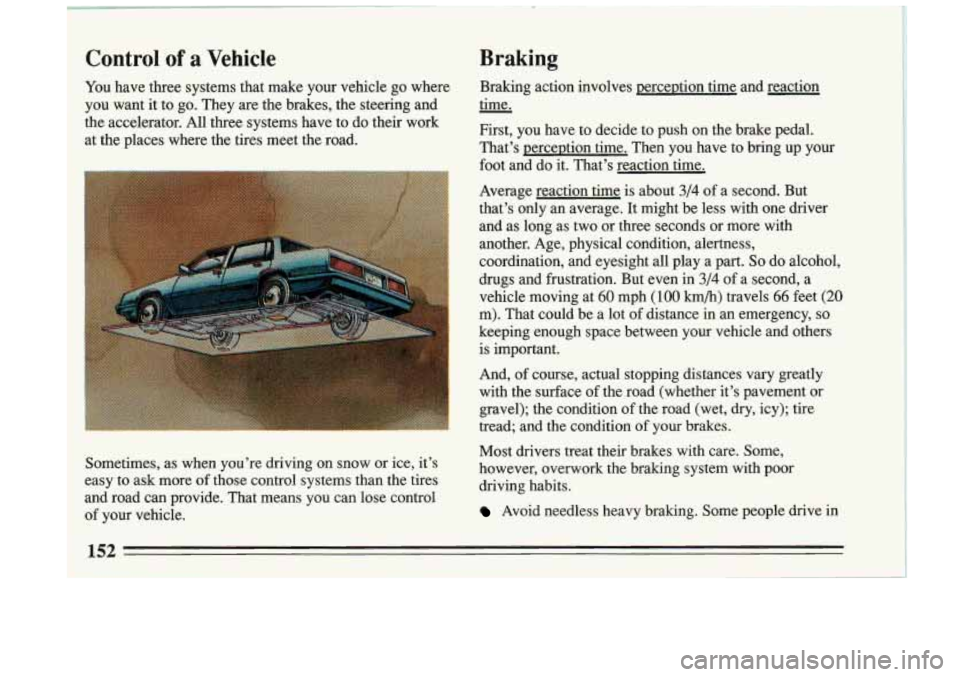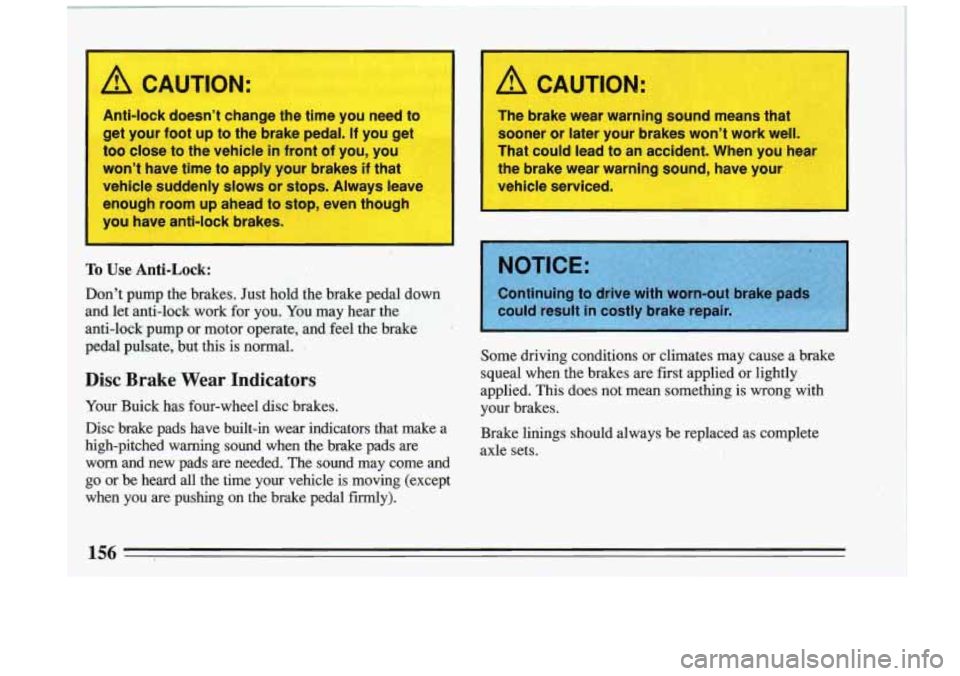Page 79 of 324
0 @ Automatic Overdrive
This position is for normal driving.
If you need more
power
for passing, and you’re:
- Going less than about 35 mph (56 km/h), push
your accelerator pedal about halfway down.
- Going about 35 mph (56 km/h) or more, push the
accelerator all the way down.
0
You’ll shift down to the next gear and have more
power.
D (Third Gear)
This is like
@, but you never go into Overdrive.
Here are some times you might choose
“ D ” instead
of
@:
- When driving on hilly, winding roads
- When going down a steep hill
2 (Second Gear)
This position gives you more power but lower fuel
economy. You can
use “2” on hills. It can help
control your speed as you
go down steep mountain
roads, but then you would also want to use your brakes
off and on.
77
Page 80 of 324
1 (First Gear) Parking Brake
This position gives you even more power (but lower
fuel economy) than
“2.” You can use it on very steep
hills, or in deep snow or mud. If the selector lever is
put in
“1,” the transaxle won’t shift into first gear
until the vehicle is going slowly enough.
The parking brakes uses the brakes on the rear wheels.
To set the parking brake:
Hold the regular brake pedal down with your right foot.
Push down the parking brake pedal with your left foot.
If the ignition is on, the brake system warning light will
come on.
Page 114 of 324

Anti-Lock Brake System Warning Light
1
I’
i
If the light stays on or comes on when you’re driving,
stop as soon as possible and turn the key off. Then start
With anti-lock, this light the engine to reset the system.
If the light still stays on,
will go on when you start or comes on again while you’re driving, your Buick
your engine and may stay needs service. Unless the regular brake system’ warning
on for several seconds or light is also on, you will still have brakes, but not
so. anti-lock brakes.
If the regular brake system warning
light
is also on, see “Brake System Warning Light”
earlier in this part.
The anti-lock brake system warning light may also come on when you are driving with
a compact spare tire. If
this happens, the light means you won’t have anti-lock
until you replace the compact spare, with a full-size tire.
If the warning light stays on after you replace the
compact spare with
a full-si.ze tire, or if it comes on
again when you’re driving, your Buick needs service.
That’s normal.
If the light doesn’t come on, have it fixed
~ so it will be ready to warn you if there is a problem.
112
Page 117 of 324
Hazard Warning Flasher Service A/C
- This light
on your
instrument panel lets you
know when you have the
hazard warning flashers
on.
When the hazard flashers are on, your turn signals will
not work.
If you apply the brakes, the flashing will stop
until’you release the brake pedal. See “Hazard Warning
Flashers” in the Index for more information.
If this light stays on 60
seconds or more, your air
conditioning system needs service. It comes
on as a
bulb cheek, whenever you
turn the ignition to “Run”.
Page 154 of 324

Control of a Vehicle Braking
You
have three systems that make your vehicle go where Braking act\
ion involves perception time and reaction
you want it to go. They are the brakes, the steering and time.
the accelerator. All three systems have to do their work First\
,
you have to decide to push on the brake pedal,
at the places where the tires meet the road.
That’s perception time. Then you have to bring up your
foot and do
it. That’s reaction time.
Average reaction time is about
3/4 of a second. But
that’s only an average. It might be less with one driver
and as long as two or three seconds or more with
another. Age, physical condition, alertness,
coordination, and eyesight all play a part.
So do alcohol,
drugs and frustration. But even in
3/4 of a second, a
~ vehicle moving at 60 mph (100 km/h) travels 66 feet (20
m). That could be a lot of distance in an emergency, so
keeping enough space between your vehicle and others
is important.
Sometimes, as when you’re driving on snow or ice, it’s
easy to ask more
of those control systems than the tires
and road can provide. That means you can lose control
of your vehicle.
~ And, of course, actual stopping distances vary greatly
with the surface of the road (whether it’s pavement or
gravel); the condition
of the road (wet, dry, icy); tire
tread; and the condition of
your brakes.
Most drivers treat their brakes with care. Some,
however, overwork the braking system with poor
driving habits.
Avoid needless heavy braking. Some people drive in
152
Page 155 of 324
spurts -- heavy acceleration followed by heavy
braking
-- rather than keeping pace ‘with traffic. This
is a mistake. Your brakes may not have time to cool
between hard stops. Your brakes will wear out much
faster
if you do a lot of heavy braking.
Don’t “ride” the brakes by letting your left foot rest
lightly on the brake pedal while driving.
I
A CAUTION:
“Riding” your brakes can cause them to
overheat to the point that they won’t work well.
You might not be able to stop your vehicle in
time to avoid an accident. If you “ride” your
brakes, they will get
so hot they will require a lot
of pedal force to slow you down. Avoid “riding”
the brakes.
I
I
153
Page 157 of 324
Here’s how anti-lock works. Let’s say the road is wet.
You’re driving safely. Suddenly an animal jumps out in
front
of you.
You slam on the brakes. Here’s what happens with
ABS.
A computer senses that wheels are slowing down. The
computer separately works the brakes at each front
wheel and at the rear wheels. You
can steer around the obstacle while braking hard.
As you brake, your computer keeps receiving updates on
wheel speed and controls braking pressure accordingly.
155
Page 158 of 324

I A CAUTION:
Anti-lock doesn’t change the time you need to
get your foot up
to the brake pedal. If you get
too close to the vehicle in front of you, you
won’t have time to apply your brakes
if that
vehicle suddenly slows or stops. Always leave
enough room up ahead to stop, even though
you have anti-lock brakes.
. 5 ’,.
To Use Anti-Lock:
Don’t pump the brakes. Just hold the brake pedal down
and let anti-lock work for you. You may hear the
anti-lock pump or motor operate, and feel the brake
pedal pulsate, but this is normal.
.
Disc Brake Wear Indicators
Your Buick has four-wheel disc brakes.
Disc brake pads have built-in wear indicators that make a
high-pitched warning sound when the brake pads are worn and new pads are needed. The sound may come and
go or
be heard all the time your vehicle is moving (except
when you are pushing on the brake pedal firmly).
I ‘
A CAUTION:
The brake wear warning sound means that
sooner or later your brakes won’t work well.
That could lead to an accident. When you hear
the brake wear warning sound, have your
:~
vehicle serviced. &tz
some driving conditions or climates may cause a brake
squeal when the brakes are first applied or lightly
applied.
This does not mean something is wrong with
your brakes.
Brake linings should always be replaced as complete
axle sets.
156